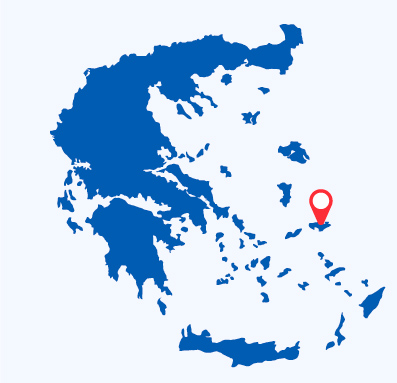We arrive on Samos Island in the Dodecanese Archipelago, the part of Greece closest to Asia Minor and Turkey.
A large island that covers almost 500 square kilometers of territory just one kilometer and two hundred meters from the Turkish coast that separates it with the Mykali Strait. A territory made up of high mountains, a dormant volcano with a peak reaching 1440 meters to be reached with fantastic walks, green valleys cultivated with olive trees and vineyards where the famous muscat of Samos is produced, dense forests of eucalyptus and oaks, bays with beaches sandy beaches and incredible coves that end in coasts with an exotic flavor and waterfalls, here's what to expect from Samos. Added to all this is the fact that it enjoys a typically Mediterranean climate which offers over three thousand hours of sunshine a year.
Unfortunately, in recent years she too has been remembered only for the invasion of migrants but if you manage not to be influenced by this aspect, know that you will be able to explore an island which lacks nothing and of extraordinary naturalistic beauty as well as important history and from the archaeological sites considered among the most notable in the world including the underground aqueduct and the sanctuary of Hera.
According to Greek mythology, Samos is the island where the Goddess Hera was born, symbol of marriage and birth. Daughter of Cronus and Rhea, she is the sister and wife of Zeus, undisputed ruler of Olympus and with a very vengeful character for just cause given her husband's recurrent infidelity who has done all sorts of things to her. Samos was also the birthplace of the scientist Pythagoras, inventor of the famous theorem.
History of Samos
It was already inhabited in the prehistoric period by a population coming from Anatolia (Turkey) and in 1000 BC it was occupied by the Ionians. Land of maritime traders, it was the first to overcome the Pillars of Hercules in 640, but its greatest prosperity occurred in 540 BC when artists, scientists and poets arrived and contributed to its economic, social and cultural development.
In the Hellenistic period it managed to maintain its independence and in 129 BC it became a Roman province of Asia. Like Rhodes, it did not participate in the Peloponnesian War and at the beginning of the 18th century it was invaded by Albanian refugees fleeing from the Ottomans where they found refuge and colonized the central part of the island. During the Turkish domination it managed to obtain a certain autonomy as the Principality of Samos until 1912 when it was annexed to the Greek State.
A holiday in Samos is chosen to stay away from the usual tourist circuits, perhaps due to the fact that there are not many direct flights from both Italy and Europe, thus forcing visitors to undertake a journey in stages, due to a varied and still uncontaminated, for idyllic and solitary beaches, for a very deep-rooted culture, for a perfect climate for most seasons, for a good food and wine offer and for a holiday dedicated to discovery and relaxation.
With over 1000 churches and monasteries with blue domes and white walls, Samos is a mix of Venetian, Byzantine and neoclassical buildings. Worth seeing is Vathy, the capital, a meeting between the old and the new. Its port in the center of the town is very lively and there is a main street full of shops. Go to the historic church of Agios Spyridon or to the building that once housed the Parliament and the Town Hall, to the Byzantine Museum in the upper part of the city also called Ano Vathi where many finds are on display testifying to the many civilizations that have passed through here. To finish the tour, five kilometers away is the Zoodohos Pigi Monastery dating back to 1756 on a promontory which offers a view of the Aegean and Asia to be immortalized in a photograph.
Pythagorion the most historic and fascinating tourist resort on Samos. Here is the legendary Hereon, the temple dedicated to Hera. Overlooking the Gulf of Tigani, its port, the first artificial one built in the Mediterranean, is the crossroads for traffic towards the other islands and from where you can also reach Ephesus in Turkey on a daily basis. A labyrinth of suggestive streets including the main Odos Lygourgou Logothi where most of the shops, cafes, bars and restaurants are located, leading up to the statue of Pythagoras and reaching the archaeological site of the ancient city dating back to 522 BC. For lovers of ancient history, a visit to the Eupalino aqueduct, the Temple of Aphrodite and the Ligkougos Castle cannot be missed. Like all seaside resorts, it has its own equipped beach with all the comforts, perfect for a day of complete laziness.
The second largest town on Samos is Karlovasi in the north-west part of Samos, one of the most fertile areas. Very close to Turkey on particularly clear days you can clearly see the Sigacik bay. It is divided into three parts, the old city, the center and the new part. Rich in neoclassical buildings and palaces, it houses the University of the Aegean which represents a unique structure that combines campuses in six islands of the Aegean Sea (Mytilene, Chios, Rhodes, Syros, Lemnos) where different faculties operate in each one. Worth seeing is the Church of the Holy Trinity which dominates the entire area and the church of Agios Nikoloas with its pinnacles and white and blue domes. With a walk through the woods you can reach the Potami waterfalls as well as its beach where the sea is fantastic and always calm. In August there is a beautiful wine festival don't miss it!
If you also want a bit of nightlife then move to Kokkari s south east. Between two headlands that protect it from the wind, it is full of places to hang out late and the people are extremely friendly and hospitable. If you like being in contact with nature then Agios Konstantinos is for you. In a lush valley full of spring water the only noise will be the chirping of nightingales. Vourlioties, on the other hand, on the slope of Mount Kavounis which can be reached from a road with an inexplicable panorama, it is so beautiful, leads to the Pnaka spring, a beautiful area of tropical vegetation where clean and very fresh water flows.
Finally, two beaches that are very difficult to reach but which will greatly reward the effort are the Mikro Seitani beach and the Megalo Seitani beach, two masterpieces of Mother Nature!
Ultimately a little-known and little-exploited island but with a lot of things to see and do, for an alternative holiday and above all away from mass tourism and confusion.

The best facilities of Samos
Selected hotels and apartments that you can book with us
Why book a holiday in Samos with us?
- For us, every person is unique and consequently so is their holiday.
- Every quote you request is personalized and tailor-made
- We take care of everything, including guaranteed 24-hour assistance
